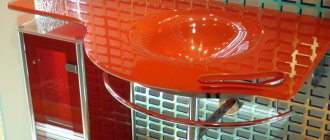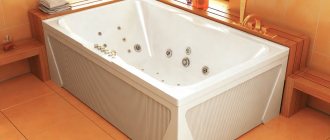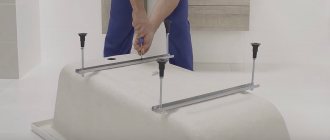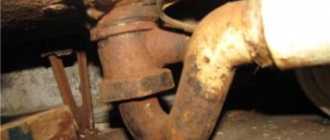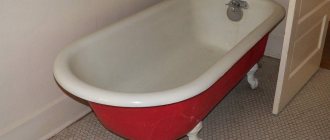Bathrooms, equipped with modern fixtures, look stylish and modern. At the same time, every detail increases the functionality of the bathroom, ensuring maximum comfort for its intensive use. These important details include a faucet mounted on the side of a bathtub, which differs from conventional mixing devices not only in appearance, but also in design, as well as in the method of connection to the facility’s water supply system.
By installing a cascade mixer on the side of the bath, you get the opportunity to create a real waterfall, controlling the flowing flow using a joystick, touch panel or half-turn lever. What is also attractive about faucets of this type is the method of attaching the shower head, in which its hose is located under the bathtub.
If necessary, the watering can is pulled out and then returned to its original position after use. This allows you to minimize the number of communications in sight, thereby increasing the ergonomics of the limited bathroom space.
Disadvantages to be aware of
Despite all the advantages that are described in detail in advertising brochures, before purchasing a faucet for a rim, you should think about a number of problems, especially if the owner of the house plans to install it himself.
First of all, you should not buy an inexpensive model, since due to the nature of their operation, these plumbing products are subject to high loads. A low-quality faucet will have to be replaced very soon.
The most vulnerable element of such a mixer is the shower hose. Most of the time it is in a curled state, so it gradually becomes deformed. Soon cracks appear on the hose, it begins to leak and requires replacement. Unfortunately, even expensive and high-quality faucets are not immune to problems with the hose.
The shower head hose of the mortise mixer is located in a coiled state behind the bathtub body or behind the false panel. Constant deformation of this element leads to its frequent breakdowns
You will have to come to terms with the fact that the hose needs to be changed periodically. Prudent buyers immediately take a spare hose to perform this simple repair as soon as the need arises. Particularly vulnerable in this regard are faucets whose spout also serves as a shower head.
Amateur craftsmen who do not have much experience in plumbing work should remember that at home it is easiest to install an on-board faucet on an acrylic bathtub. When working with a product made of cast iron or steel, the enamel will almost certainly be damaged, which can cause corrosion. As a result, the bathtub will have to be repaired or completely replaced.
It is better for an inexperienced master to entrust this work to a reliable specialist. Another way to solve the problem is to purchase a bathtub with a ready-made hole for installing a mixer. True, acrylic bathtubs are usually supplied with this option. Of course, when choosing a mixer, you will have to take into account the size of such a hole.
Illuminated faucets: installation options
Faucets with built-in water lighting are an incredibly beautiful and modern solution for your bathroom.
Illuminated faucets can be embedded into the side of the bathtub, mounted into the wall or installed on the sink. Backlight options are also different. In some models, the color of the water will change with the change in temperature, in others the backlight will always be the same color. You can choose the color that best suits the interior of your bathroom, or you can change the water lighting to suit your mood - some models provide this too.
In any case, the effect will be simply amazing. Can you imagine how beautiful luminous streams of water will look in the twilight of a bathroom? A romantic mood for you and your partner will be guaranteed!
Features of the design of a mortise mixer
For installation on the side of the bathtub, manufacturers most often offer so-called modular models, although there is also an option in the form of a monoblock. Before starting installation, you should carefully study the design of your mixer, as well as the manufacturer’s recommendations for its installation and further operation.
Elements of a modular type mortise mixer can be installed separately, but they are controlled from a common center, which increases the level of comfort
Monoblock models are usually supplied assembled, but modular devices consist of several elements.
First of all, this is the tap - the central part of the mixer, on the body of which there are three outlets:
- for hot water;
- for cold water;
- for spout.
There is a separate space for connecting a shower head. These entrances have standard sizes, so the buyer can decide for himself exactly where the spout and shower head will be located. The connection to hot and cold water pipes is made using special half-inch eccentrics.
This diagram allows you to get an idea of the features of installing a mortise mixer on the side of an acrylic bathtub, as well as the necessary consumables
High-quality mortise mixers from well-known brands have the ability to withstand quite serious water hammer. In many models, the separately located shower head is controlled by a lever mounted on the spout body. This design automatically switches the water supply from the shower back to the spout when the watering can is returned to its place.
Floor standing columns with mixer tap
Fans of non-standard technical solutions will certainly appreciate such an innovation in the field of bathroom design as a floor stand for a faucet. It is a structure in the form of a metal column about one and a half meters high, to which a shower, spout and control levers are attached. The water distribution is carried out under the floor, so this version of the mixer is suitable only for those who are renovating the bathroom starting from the “concrete box” stage.
The stand is especially convenient for bathtubs of non-standard shapes, as well as for bathtubs installed far from the walls.
Such a counter will become a real decoration of your bathroom, that very “highlight” that will add sophistication and style to the bathroom interior.
A faucet stand made of shiny, silver metal will look great in a high-tech bathroom, while the same stand with a brass or gold finish is simply created for bathrooms in a retro or modern style.
Related article: Console sink (with legs)
A floor column for a faucet is quite an expensive proposition, as it is usually made from the highest quality materials and, moreover, requires professional installation.
But, having decided to buy, you are unlikely to regret it, since this thing can serve you for many years, maintaining its beauty and originality.
Some useful tips
The best time to install a faucet on an acrylic bathtub is during the period of renovation and installation of a new bathtub. Installation of the device is carried out before connecting the bath to the sewer and installing a decorative screen.
If you decide to replace a conventional wall-mounted faucet with a mortise model, you will have to carry out some finishing work after installing and dismantling the old faucet.
To provide access to the communications of a mixer installed on the side of the bath, you can use a convenient folding screen, false panel or inspection hatch
It is possible that the entire bathtub will have to be dismantled and installed again. These costs of time, effort and money must be taken into account. If it is necessary to install a non-removable version of the decorative bath screen, you can make an inspection hatch in it to provide access to communications.
When installing a mortise mixer on the side of an acrylic bathtub, manufacturers recommend using a special strip. Indeed, acrylic is not as durable a material as cast iron or steel. According to manufacturers, the presence of a hole in the side weakens the structure. Planks and panels serve to strengthen the side and prevent its possible deformation.
In practice, masters do not attach importance to this point and do without any planks. This element often has to be trimmed and adjusted to the size and configuration of the side. The side usually has a rounded shape, which significantly complicates such an adjustment.
In order not to tinker with this problem and waste time, home craftsmen simply ignore the manufacturer’s recommendations.
Fortunately, there have been no reports of a collapsed faucet installed without a bracket yet. Nevertheless, one should remember this danger and wisely assess the balance of risks and costs for installing a reinforcing strip. If its shape matches the configuration of the side, it makes sense to strengthen the structure.
Device and advantages
A bathtub is a sanitary container made of cast iron, stainless steel or acrylic, which is used to meet human hygienic needs. Traditionally, there are two holes in the bathroom bowl - a drain and an overflow. Such models assume that the mixer and taps will be installed on the wall. Now new types of bathtubs have appeared on sale, which have a hole in the side for installing a mixer. The mixer installed on the side of the font has the following advantages:
- Cleaner, quieter bath filling. Filling the wash container with water can be a rather long and noisy process. The fact is that water falling from a height hits metal walls, which amplify the sound of its fall. In addition, if the faucet is located high, splashes may fly from the faucet, which spoil the wall decoration or furniture, and increase the overall harmoniousness of the room.
- Comfortable use. When the faucet and faucet are located high, you must stand on a slippery surface of the bathroom to close or open it, which often causes falls and injuries. And if the faucet is on the side of the bathroom, you can easily reach it with your hand without getting up.
- Aesthetics. Built-in plumbing equipment installed on the side of the font looks more neat and aesthetically pleasing. This installation method allows you to disguise the hoses from the watering can and hide all communications.
Features of drilling through enamel
In addition to the usual tools, such as a marker, tape measure, screwdriver and drill, you will need a special feather drill designed for drilling glass and ceramics, as well as transparent tape and a piece of plasticine. After marking, the drilling site should be carefully sealed with tape.
Then you need to make a round side from a piece of plasticine and stick it around the circumference so that the place for drilling is in the center. The area limited by the plasticine side should be three times the size of the hole for the mixer. It turns out to be a flat round platform with a side. You need to pour water into it.
After this, you can start drilling in the center of the marking. It is recommended to use a drill with a diameter of 6mm at a speed of about 500-600 revolutions. The pressure should be moderate. During such careful drilling, a narrow through hole will appear in the side of the bathtub, through which the water present at the drilling site will flow out.
Now you should make a small cap from plasticine and stick it to the bottom of the side so that the resulting hole is in the center. You need to pour water again and re-drill using a 12 mm drill. The pressure should be light. When the drill goes right through the side, you can remove all the plasticine and evaluate the quality of the work; chips on the enamel should be minimal.
After this, you need to widen the hole to the required size to install the mixer. To do this, new markings are made, indicating the boundaries of the hole. The surface must be sealed again with transparent tape.
The hole should be widened using a grinder using a rubber attachment with sandpaper. The speed should be set to maximum, but the applied force should remain minimal.
Experts do not recommend that beginners make holes in the side of a cast iron or steel bathtub themselves. Problems are caused by the presence of enamel, which performs not only decorative, but also protective functions. If drilling is done incorrectly, there is a high risk of irreversible damage to this layer.
When the hole is wide enough, you can use a nozzle with a diameter of 20 mm. It should be understood that with minimal effort, which will protect the enamel from damage, the work will not progress too quickly. You will have to work with the grinder for more than an hour. When the hole is ready, insert the o-ring into it and install the mixer in the usual manner.
There are other ways to accurately drill into enamel surfaces. Some craftsmen simply glue a metal plate to the enamel and drill through such a “sandwich”. The metal will protect the enamel from damage. Others carefully remove some of the enamel with a grinder before drilling, and then drill with a hole saw.
Finally, there is a way to drill into cast iron with a diamond core cutter using a wood jig. But in this case, the cutter must be cooled quite often by pouring water on it.
Types, pros and cons of bath faucets
A mixer mounted on the side of the bathtub is suitable when the bathtub is located at a distance from the wall.
The bathtub must be selected with sides 7-8 centimeters wide. These devices are made of brass, which is distinguished by its durability. The top is covered with a chromium-nickel coating, which gives a mirror shine and protects against corrosion. For some models, the manufacturer provides up to a five-year warranty.
We classify on-board mixers according to the following criteria: Based on the type of installation, they are divided into :
- external installation - the device is a monoblock, its parts - mixer, spout, valve, shower head with hose - are assembled into one structure, which is mounted on the side of the bathroom, and the water mixing unit is under the side.
- hidden installation (mortise installation) - the device is not a single structure, but functional parts, each performing its own function.
Individual elements:
- control lever;
- spout;
- Shower Heads.
Each of them is attached to the bathtub body. And each can be installed independently of the other.
This is the distinctive feature of this type of mixers. And parts and components, including the shower hose, are hidden behind the side of the bath. This type is called mortise, since for installation in the side of the bathroom you need to cut holes in the amount of one to five, depending on the number of components.
According to the installation diagram and layout of the mixer parts, they are divided into:
- two holes - a shower head, valves and spout are mounted on the side of the bathroom;
- three holes - two control levers and a spout are mounted on the side of the bathroom, or two control levers and a shower head;
- four to five holes - a shower head, spout and three control levers are mounted on the side of the bathtub.
Listed above are approximate options for the arrangement of parts. In mortise models, the watering can and shower hose deserve attention. The watering can is retractable, and the hose is “hidden” behind the side of the bathroom. If necessary, the hose is pulled out from under the bathtub by pulling the watering can towards you.
The hose extends to a length of 1.2 meters for mortise installation, and to a length of 1.6 meters for external installation.
According to the type of spout they are divided into:
- spout (spout). The lengths are long, medium and short. Geometric shape - triangular, square or round. In addition, they are distinguished by the manufacturing method - tubular, soldered and cast.
- Tubular - an economical option. The mixer looks like a metal curved tube. Since its design does not contain small parts and expensive materials, it is inexpensive. There must be two fixation rings. Brazed - more expensive than tubular models. More often they have an original shape and attract attention with their design.
- Cast ones are an expensive option. Made from die-cast construction. It is a heavy structure, as it is manufactured by casting the body; cutting and soldering are not used.
Spouts are made of brass; only cast structures are made of metal from more durable materials. There are also stainless steel products, but their quality is worse than that of brass spouts.
A qualitative characteristic of a spout is its throughput - how much water it passes per unit of time.
The throughput depends on the diameter of the hole and the length of the spout.
The larger the diameter and shorter the spout, the greater its capacity, although the difference is small. In addition, you need to consider the design of the bathroom. For example, short, rectangular or oval-shaped models are suitable for modern style, and long, curved models are suitable for classic and retro styles.
Cascade - looks like a small waterfall. Comes with additional lighting. The device is practically no different from ordinary spouts. The supply of cold and hot water and its mixing follows the same principle.
The only difference is the shape of the spout, which is a panel made of metal or plastic, which has a narrow opening - a slot. Through this hole, water pours out in a flat and wide stream, which resembles a waterfall. The throughput capacity, and accordingly the bath filling speed, of such faucets is 2 times greater than that of conventional spouts.
Advantages of the cascade:
- design;
- the bath fills up several times faster due to increased water flows;
- There is less splashing of water due to the fact that in a faucet with a cascade spout the water flow is directed not to the bottom, but to the side of the bathtub.
Disadvantages of the cascade:
- high price;
- inconvenient design of the mixer when you need to pour water into a container.
According to the water control device . Joystick (lever) - devices with one lever that regulates both temperature and water pressure. There are two types of lever mixer - cartridge and ball.
The ball base consists of a metal ball, which has three holes - for hot, cold and mixed water. The container inside the ball is called the mixing chamber. The ball is in contact with rubber seals. When the movement of the ball changes, the force of the water flow also changes.
Pros of a ball lever mixer:
- the design of such a crane is reliable and rarely fails;
- low cost.
Disadvantages of a ball lever valve:
- Rubber seals need to be changed periodically.
In a cartridge (ceramic) device, instead of a ball, there is a cartridge consisting of two ceramic plates. At the top of the cartridge the water is mixed, and at the bottom there are three holes for water.
As soon as the position of the joystick (lever) changes, the mixing chamber of the upper part is aligned with one of the holes in the lower plate. The lever is coated with silicone grease and due to this it moves smoothly.
Advantages of cartridge (ceramic) taps:
- reliable design;
- there are no rubber seals, which reduces the likelihood of leaks;
- low cost.
Disadvantages of cartridge (ceramic) faucets:
- small mechanical particles in the water can damage the mechanism, so it is recommended to use cleaning filters;
- After some time, the cartridges may need to be replaced.
- two-valve (two-handle) - more often found in outdoor models, in retro style. It is a design with two valves, one regulates cold water, and the other hot. Simple and reliable design.
There are two varieties:
- The design of the valves uses a valve axle with a rubber seal. The seal becomes thinner due to exposure to temperatures and over time, and leaks may occur. For this reason, the seal needs to be changed periodically. This model is one of the most reliable.
- Half-turn. The design operates on the principle of aligning the holes of a ceramic plate. The mechanism starts working when the valve is turned just ? turnover. For a longer service life of this model, a water filter is required.
The advantages of two-valve mixers include their low cost. The disadvantages are the periodic need to replace rubber seals.
- thermostatic taps - are a device with a programming function, due to which the water temperature is set once and is subsequently maintained by the device itself. The water pressure can also be adjusted. Equipped with two regulators, one is responsible for the temperature, the other for the water pressure.
Thermostatic taps are divided into two types:
- electronic - have a liquid crystal display that displays water temperature indicators. Can be powered by batteries or mains. Controlled by buttons or touch panel. There are models that work remotely (after sending a signal from infrared sensors).
- mechanical - the water temperature is regulated by devices in the form of valves or levers.
Pros of thermostatic taps:
- You can set the temperature once, and then only adjust the water pressure;
- the possibility of burns with hot water is eliminated (for children) due to the fact that the water is adjusted according to temperature;
- Water is saved because no additional time is spent adjusting the temperature.
Disadvantages of thermostatic taps:
- high price.
Advantages of an onboard mixer
- Space is saved due to the fact that the wall next to the bathroom is not occupied by anything, this allows you to hang shelves or a mirror on it.
- This device allows you to approach the issue of bathroom design differently, since this type of faucet can be installed not only on the side of the bathroom, but also on horizontal and vertical surfaces, as your imagination allows.
- It is convenient to use due to the fact that each part can be installed independently, for example: install the shower head into the wall or into the side;
- The spout can be installed at the base of the bathtub;
- The spout control handle can be placed in any place convenient for operation.
Cons of an onboard mixer
- The cost is two or more times higher than a wall-mounted bathroom faucet.
- Quick failure of the shower hose. Since it is hidden behind the side of the bathroom, in order to use the shower head, the hose must be pulled out through a special hole. Thus, it wears out faster - the service life for hidden installation is from two months to two years, while for external installation it can be up to five years.
- In the event of a breakdown, hidden parts are not easily accessible. This must be taken into account in advance. Provide an inspection hatch for access, in addition, use only high-quality materials during installation.
- Leaks from the watering can through the hose behind the bath are possible; in the future, this will lead to the formation of fungus and mold under the bath.

